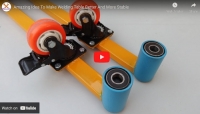Fusion welding is fast, strong, cost effective, and clean. It is very common and is used whenever the various parameters of the joint allow it. Eg, thickness, gap, alloy, etc. (to many to list here). There is nothing more cost effective because there is no consumable (eg., tungsten, or rod) and it is very quick to set up. It is quite strong because you are using only the parent metals which flow together readily and no added rod of mystery alloy. The only downside is the HAZ. But HAZ is one of the variables to consider and fusion wouldn't be used if contraindicated. I agree there may be editing involved (some of the stitch welds appear to have rod added) but TIG tacking with no rod is an everyday occurrence. Fusion was most common with acetylene welding but quickly adopted for TIG.
PS: I have set up sheet metal seams many feet/meters long to be ONLY fusion welded. First used many moons ago with oxy-acetylene and currently with TIG.



 LinkBack URL
LinkBack URL About LinkBacks
About LinkBacks


 Reply With Quote
Reply With Quote




Bookmarks